The 2007 MacTech 25 “honors the most influential people
The 2007 MacTech 25 “honors the most influential people in the Macintosh community”. Includes a single woman.



This site is made possible by member support. 💞
Big thanks to Arcustech for hosting the site and offering amazing tech support.
When you buy through links on kottke.org, I may earn an affiliate commission. Thanks for supporting the site!
kottke.org. home of fine hypertext products since 1998.
The 2007 MacTech 25 “honors the most influential people in the Macintosh community”. Includes a single woman.
Apple has released three new iPhone ads in advance of the device’s release date on June 29. The third ad is the money spot. The only remaining question: how likely am I to get one within a week or two of release without standing in line for hours on end? (via df, who notes that “No other cell phone is advertised by showing off the user interface.”)
Nice summary of the Steve Jobs/Bill Gates conversation at the D: All Things Digital conference. “Asked to give advice for others considering starting their own businesses, Gates explained that in the early days, he and his colleagues never considered the value of the company they were developing. ‘It’s all about the people and the passion, and it’s amazing the business worked out the way it did.’” Here’s a briefer summary with context and a transcript and video of the entire interview is available on the conference site.
Winners of the 2007 National Design Awards, including Apple’s Jonathan Ive and Chip Kidd.
Why has Apple’s focus on industrial design been so successful? “The most fundamental thing about Apple that’s interesting to me is that they’re just as smart about what they don’t do. Great products can be made more beautiful by omitting things.” (via justin)
Panic has released Coda, a new web development app for OS X. Panic co-founder Cabel Sasser describes it thusly:
We build websites by hand, with code, and we’ve long since dreamed of streamlining the experience, bringing together all of the tools that we needed into a single, elegant window. While you can certainly pair up your favorite text editor with Transmit today, and then maybe have Safari open for previews, and maybe use Terminal for running queries directly or a CSS editor for editing your style sheets, we dreamed of a place where all of that can happen in one place.
Ever since I switched to a Mac, I’ve been seeking a suitable replacement/upgrade for Homesite. I limped along unsatisfied with BBEdit and am finally getting into the groove with TextMate, but the inter-app switching — especially between the editor, FTP client, and the terminal — was really getting me down. John Gruber has a nice preview/review of Coda:
Each of Coda’s components offers decidedly fewer features than the leading standalone apps dedicated to those tasks. (With the possible exception of the terminal - I mean, come on, it’s a terminal.) This isn’t a dirty secret, or the unfortunate downside of Coda only being a 1.0. Surely Coda will sprout many new features in the future, but it’s never going to pursue any of these individual apps in terms of feature parity.
The appeal of Coda cannot be expressed solely by any comparison of features. The point is not what it does, but it how it feels to use it. The essential aspects of Coda aren’t features in its components, but rather the connections between components.
Panic’s implicit argument with Coda is that there are limits to the experience of using a collection of separate apps; that they can offer a better experience - at least in certain regards - by writing a meta app comprising separate components than they could even by writing their own entire suite of standalone web apps. Ignore, for the moment, the time and resource limitations of a small company such as Panic, and imagine a Panic text editor app, a Panic CSS editor app, a Panic web browser, a Panic file transfer/file browser app - add them all together and you’d wind up with more features, but you’d miss the entire point.
Panic co-founders Steven Frank and Cabel Sasser both weigh in on the launch. Has anyone given Coda a shot yet? How do you find it? I’m hoping to find some time later today to check it out and will attempt to report back.
Citing the resource-hungry iPhone as the culprit, Apple announced that they’ve pushed back the launch date for the new version of OS X (codename: Leopard) from June to October. “iPhone contains the most sophisticated software ever shipped on a mobile device, and finishing it on time has not come without a price — we had to borrow some key software engineering and QA resources from our Mac OS X team.”
Apple and EMI jointly announced earlier this week that the iTMS would offer EMI’s music without DRM and at a bitrate of 256 kps instead of 128 kps. Twice the bitrate = twice as good, yeah? Not so fast…you might not even notice the difference.
Apple will begin to sell DRM-free songs from EMI via the iTunes Music Store in May. The songs are higher quality but will cost slightly more ($1.29 vs $0.99 for the DRM version). It’ll be interesting to see how many people choose to buy the non-DRM stuff at the higher price. My feeling is that typical consumers won’t care that much…lower price will win out over slightly higher quality and some nebulous future flexibility. I bet EMI is even half-hoping for failure on this thing: “see, customers *want* DRM…”
Artist Christian Marclay says that Apple contacted him about using his short film Telephones for their iPhone commercial. He refused and they went ahead and made the commercial using the same idea with different footage. Says Marclay, “the way they dealt with the whole thing is pretty sleazy”. TouchExplode gets credit for spotting the reference. (via df)
Not sure why I’m surprised, but when Apple came up with the idea for their Apple Stores, they appoached the design of the stores like they would any other product: they built a prototype first:
“One of the best pieces of advice Mickey ever gave us was to go rent a warehouse and build a prototype of a store, and not, you know, just design it, go build 20 of them, then discover it didn’t work,” says Jobs. In other words, design it as you would a product. Apple Store Version 0.0 took shape in a warehouse near the Apple campus. “Ron and I had a store all designed,” says Jobs, when they were stopped by an insight: The computer was evolving from a simple productivity tool to a “hub” for video, photography, music, information, and so forth. The sale, then, was less about the machine than what you could do with it. But looking at their store, they winced. The hardware was laid out by product category - in other words, by how the company was organized internally, not by how a customer might actually want to buy things. “We were like, ‘Oh, God, we’re screwed!’” says Jobs.
But they weren’t screwed; they were in a mockup. “So we redesigned it,” he says. “And it cost us, I don’t know, six, nine months. But it was the right decision by a million miles.” When the first store finally opened, in Tysons Corner, Va., only a quarter of it was about product. The rest was arranged around interests: along the right wall, photos, videos, kids; on the left, problems. A third area - the Genius Bar in the back - was Johnson’s brainstorm.
Lots of other great stuff in the article as well. Sounds like the Apple Store is an underrated piece of Apple technology.
Steven Johnson, new Apple rumors blogger, reads the tea leaves and surmises that Apple will soon release multitouch displays to go with Leopard and a new version of iLife.
A commercial for the iPhone aired during the Oscars last night. Rick Silva noticed that it was a lot like artist Christian Marclay’s 1995 piece Telephones (the relevant clip starts at 3:40) and, to a lesser extent, Matthias Mueller’s film, Home Stories. Nice detective work!
Update: Here’s a list of all the actors in the iPhone commercial (except one).
Update: The missing “French Woman” is Audrey Tautou from Amelie. (thx to several folks who wrote in)
Steve Jobs’ thoughts on music and DRM. Sounds like he’d rather that music sold via the iTMS didn’t have DRM built in.
Not too many people are paying attention, but the Energy Policy Act of 2005 lengthened daylight saving time by four weeks in the US. Instead of beginning the first Sunday of April and running through the last Sunday in October, daylight saving time will now stretch from the second Sunday in March to the first Sunday in November. The Washington Post has an article today about the change and what impact it might have on automated systems:
The change takes effect this year — on March 11 — and it has angered airlines, delighted candy makers and sent thousands of technicians scrambling to make sure countless automated systems switch their clocks at the right moment. Unless changed by one method or another, many systems will remain programmed to read the calendar and start daylight saving time on its old date in April, not its new one in March.
The article mentions that older Microsoft products like Windows XP SP1 and Windows NT4 might require manual updates and Daring Fireball has had a few updates about how the switch effects Mac users, including this piece at TidBITS. But what about everything else? Is the version of Movable Type I’m using going to make the adjustment? What about Wordpress? Perl? Ruby? PHP? Java? Linux? I’m sure the current versions of all these programs and languages address the issue, but are there fixes and patches for those running old versions of Perl on their server?
If you’ve got any information about programs, applications, and languages affected by the change and how to address the problem, leave a comment on this thread. I’ll update the post as information comes in.
Music industry: CD prices are being driven down by $9.99 albums on iTunes Music Store. “Physical retailers are pressuring the labels downward on price (of course, Wal-Mart is the biggest culprit) because they don’t want to be undercut by iTunes 9.99 on all single albums. We’re rapidly moving to a 9.99 world on the big sellers (the ones stocked in Target and Wal-Mart and Best Buy).”
Mac geek proposes to girlfriend via F12 key and a Dashboard widget. See also Apple Store marriage proposal.
OhMiBod is the ultimate iPod accessory: a vibrator that hooks up to the iPod and buzzes in time with the music. “I will never listen to music the same way again.” Don’t miss the playlists compiled specifically for OhMiBod use. NSFW. (thx, tania)
David Pennock on the steep rise of Apple’s stock after announcing the iPhone: “Jobs’s speech could not possibly have revealed over $8 billion in previously undisclosed information”.
Update: On the other hand, analysts think that Steve Jobs’ mere presence at the company is worth $20 billion.
Lengthy interview with Steve Jobs from 1995. “I’m convinced that about half of what separates the successful entrepreneurs from the non-successful ones is pure perseverance.”
Here’s how MacRumors did their livecast of Steve Jobs’ MacWorld keynote. At one point, the site had 213,000 simultaneous visitors.
Booksquare surmises that turned sideways, the iPhone — with its bright 160 ppi screen — will be pretty decent for reading books and such. (via o’reilly)
Video from CBS News of an iPhone demonstration. (via blurbomat)
Regarding some of the points in my iPhone round-up from yesterday, David Pogue has some answers to those questions and a whole lot more in his iPhone FAQ. “Is it ambidextrous? -No.” What does that even mean? As a lefty, am I out of luck? (via df)
By now you’ve all heard about the iPhone and read 60 billion things about it, so I’ll get straight to it. I’ve been tracking some of the best points from around the web and jotted down some thoughts of my own.
Caveat: Evaluating an interface, software or hardware, is difficult to do unless you have used it. An interface for something like a mobile phone is something you use on the time-scale of weeks and months, not minutes or hours. There are certain issues you can flag as potential problems, challenges, or triumphs after viewing demos, descriptions of functions, and the like, but until you’re holding the thing in your hand and living with it day-to-day, you really can’t say “this is going to work this way” or “I don’t like the way that functions” with anything approaching absolute confidence. With that said:
The touchscreen text entry is the biggest issue with the iPhone. If it works well, the iPhone has a good shot at success, and if not, it’s going to be very frustrating for those that rely on their mobile for text…and every potential customer of the iPhone is going to hear about that shortcoming and shy away.
What *is* fantastic about the iPhone is the way that they’ve put it all together; features are great, but it’s all about the implementation. Apple stripped out all the stuff you don’t need and made everything you do need really simple and easy. (That’s the way it appears anyway…see above caveat.)
One reason there’s limited innovation in cell phones generally is that the cell carriers have stiff guidelines that the manufacturers have to follow. They demand that all their handsets work the same way. “A lot of times, to be honest, there’s some hubris, where they think they know better,” Jobs says. “They dictate what’s on the phone. That just wouldn’t work for us, because we want to innovate. Unless we could do that, it wasn’t worth doing.” Jobs demanded special treatment from his phone service partner, Cingular, and he got it. He even forced Cingular to re-engineer its infrastructure to handle the iPhone’s unique voicemail scheme. “They broke all their typical process rules to make it happen,” says Tony Fadell, who heads Apple’s iPod division. “They were infected by this product, and they were like, we’ve gotta do this!”
Several people have speculated that the iPhone’s version of OS X is actually a preview of what we’ll be getting with Leopard, the next version of Mac OS X.That is to say the core operating system at the core of Mac OS X, the computer OS used in Macs, and “OS X”, the embedded OS on the iPhone. More on this soon in a separate fireball, but do not be confused: Mac OS X and OS X are not the same thing, although they are most certainly siblings. The days of lazily referring to “Mac OS X” as “OS X” are now over.
Apple has figured out a way to retain a hold on hearts and minds in a business previously based on bytes. I applaud its designs, I worry about its tactics and what they mean for the future of marketing and group think. A group that wants our devotion but doesn’t need the press, doesn’t want the press, can’t keep the press off its backs, is a group that’s more interested in mind control than in improving lives with its products.
And that’s enough, I think.
The iPhone runs on OS X, right? So theoretically, shouldn’t you be able to run IE for Windows XP in Parallels?
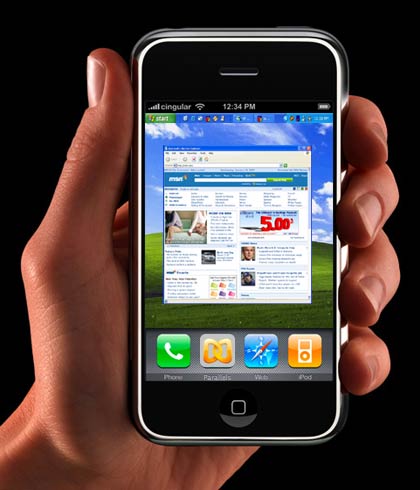
Comparison of the iPhone with other smart phones…a nice companion piece to the comparison of my cardboard iPhone to various iPods, mobile phones, etc. So far, the market thinks that Apple’s got something good on their hands: Apple stock was up $7.10 today while RIMM (makers of Blackberry) dropped $11.16.
Apple’s new iPhone looks like a thing of beauty. Widescreen touch interface, no buttons, runs OS X, useful widgets, integrated email, Google Maps, Google/Yahoo search, visual voicemail (see who voicemail is from before you call), SMS, Wifi, etc. etc. Oh, and it plays music.
A lot of people are wondering just how big this thing is. Using the technical specs from apple.com, I grabbed some cardboard, scissors, and glue and made a scale model of the iPhone. Here it is:
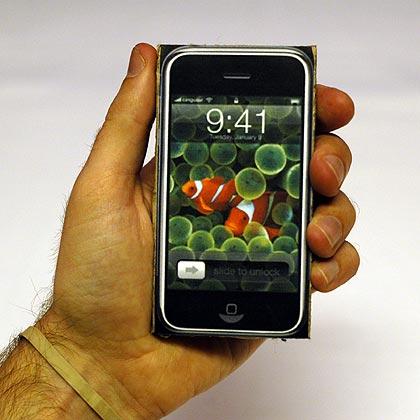
My hands aren’t that big (I can barely palm a basketball on a good day), but it still seems to fit pretty well. How does it stack up against similar devices?
Here’s the iPhone vs. my current mobile phone, the Nokia 7610:
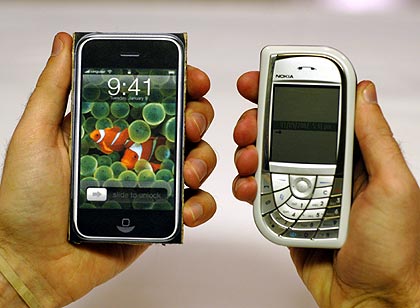
iPhone vs. a 5G iPod:
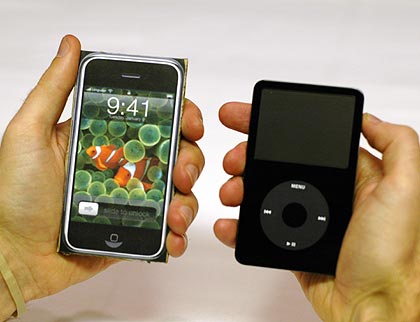
Thickness of the cardboard iPhone vs. the 5G iPod:
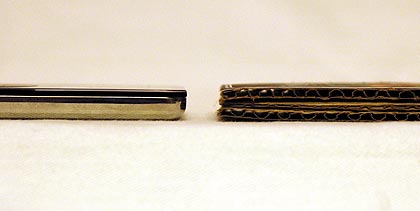
1G iPod shuffle, 3G iPod, 5G iPod and the iPhone:
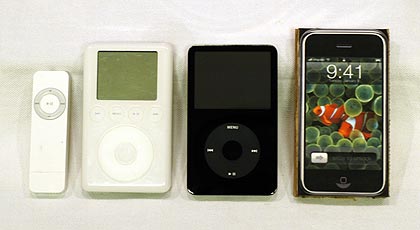
iPhone vs. a TiVo remote and a Wii remote:
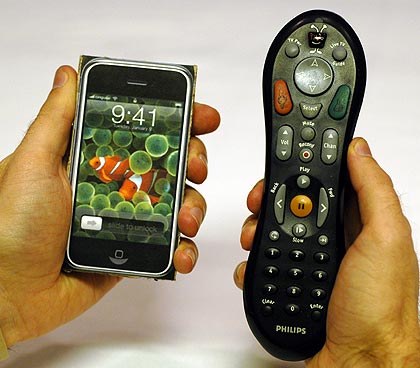
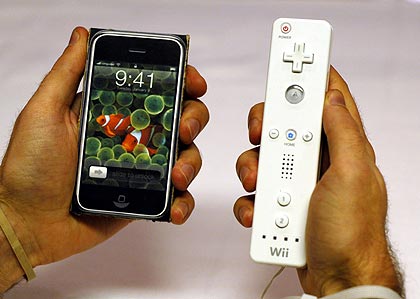
That’s all the gadgets I could find on a couple of hours notice.
I also dug up something I wrote a couple of years ago in the gigantic text file I keep on my Powerbook of ideas for kottke.org posts. 99% of the stuff in that file is completely dunderheaded, but I have to say I hit close to the mark on this one:
true convergence of phone + mp3 player will happen when someone solves this user experience puzzle: physically not enough room for two optimized interfaces (one for calls, one for music) on same small device. possible solution: no buttons, replace with touch screen that covers the whole front with one-touch switching between modes…
Once we’re able to get our hands on it and use the interface, the iPhone could turn out to be a disappointment, but they’re heading in the right direction at least. More thoughts soon.
(Like this story? Digg it.)
Stay Connected